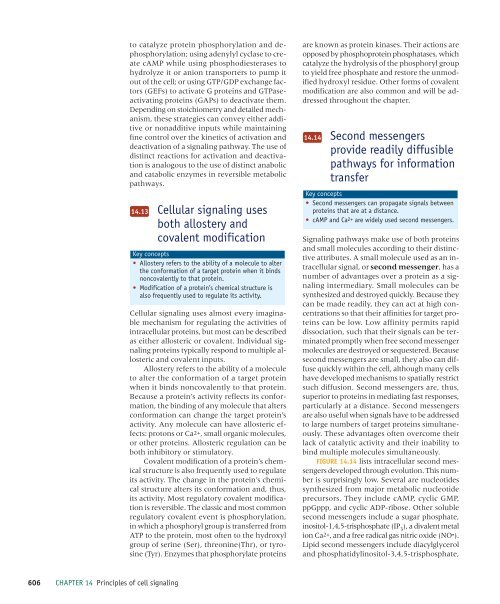Principles of cell signaling - UT Southwestern
Principles of cell signaling - UT Southwestern
Principles of cell signaling - UT Southwestern
Create successful ePaper yourself
Turn your PDF publications into a flip-book with our unique Google optimized e-Paper software.
39057_ch14_<strong>cell</strong>bio.qxd 8/28/06 5:11 PM Page 606<br />
to catalyze protein phosphorylation and dephosphorylation;<br />
using adenylyl cyclase to create<br />
cAMP while using phosphodiesterases to<br />
hydrolyze it or anion transporters to pump it<br />
out <strong>of</strong> the <strong>cell</strong>; or using GTP/GDP exchange factors<br />
(GEFs) to activate G proteins and GTPaseactivating<br />
proteins (GAPs) to deactivate them.<br />
Depending on stoichiometry and detailed mechanism,<br />
these strategies can convey either additive<br />
or nonadditive inputs while maintaining<br />
fine control over the kinetics <strong>of</strong> activation and<br />
deactivation <strong>of</strong> a <strong>signaling</strong> pathway. The use <strong>of</strong><br />
distinct reactions for activation and deactivation<br />
is analogous to the use <strong>of</strong> distinct anabolic<br />
and catabolic enzymes in reversible metabolic<br />
pathways.<br />
14.13<br />
Cellular <strong>signaling</strong> uses<br />
both allostery and<br />
covalent modification<br />
Key concepts<br />
• Allostery refers to the ability <strong>of</strong> a molecule to alter<br />
the conformation <strong>of</strong> a target protein when it binds<br />
noncovalently to that protein.<br />
• Modification <strong>of</strong> a protein’s chemical structure is<br />
also frequently used to regulate its activity.<br />
Cellular <strong>signaling</strong> uses almost every imaginable<br />
mechanism for regulating the activities <strong>of</strong><br />
intra<strong>cell</strong>ular proteins, but most can be described<br />
as either allosteric or covalent. Individual <strong>signaling</strong><br />
proteins typically respond to multiple allosteric<br />
and covalent inputs.<br />
Allostery refers to the ability <strong>of</strong> a molecule<br />
to alter the conformation <strong>of</strong> a target protein<br />
when it binds noncovalently to that protein.<br />
Because a protein’s activity reflects its conformation,<br />
the binding <strong>of</strong> any molecule that alters<br />
conformation can change the target protein’s<br />
activity. Any molecule can have allosteric effects:<br />
protons or Ca2+, small organic molecules,<br />
or other proteins. Allosteric regulation can be<br />
both inhibitory or stimulatory.<br />
Covalent modification <strong>of</strong> a protein’s chemical<br />
structure is also frequently used to regulate<br />
its activity. The change in the protein’s chemical<br />
structure alters its conformation and, thus,<br />
its activity. Most regulatory covalent modification<br />
is reversible. The classic and most common<br />
regulatory covalent event is phosphorylation,<br />
in which a phosphoryl group is transferred from<br />
ATP to the protein, most <strong>of</strong>ten to the hydroxyl<br />
group <strong>of</strong> serine (Ser), threonine(Thr), or tyrosine<br />
(Tyr). Enzymes that phosphorylate proteins<br />
are known as protein kinases. Their actions are<br />
opposed by phosphoprotein phosphatases, which<br />
catalyze the hydrolysis <strong>of</strong> the phosphoryl group<br />
to yield free phosphate and restore the unmodified<br />
hydroxyl residue. Other forms <strong>of</strong> covalent<br />
modification are also common and will be addressed<br />
throughout the chapter.<br />
14.14<br />
Second messengers<br />
provide readily diffusible<br />
pathways for information<br />
transfer<br />
Key concepts<br />
• Second messengers can propagate signals between<br />
proteins that are at a distance.<br />
• cAMP and Ca2+ are widely used second messengers.<br />
Signaling pathways make use <strong>of</strong> both proteins<br />
and small molecules according to their distinctive<br />
attributes. A small molecule used as an intra<strong>cell</strong>ular<br />
signal, or second messenger, has a<br />
number <strong>of</strong> advantages over a protein as a <strong>signaling</strong><br />
intermediary. Small molecules can be<br />
synthesized and destroyed quickly. Because they<br />
can be made readily, they can act at high concentrations<br />
so that their affinities for target proteins<br />
can be low. Low affinity permits rapid<br />
dissociation, such that their signals can be terminated<br />
promptly when free second messenger<br />
molecules are destroyed or sequestered. Because<br />
second messengers are small, they also can diffuse<br />
quickly within the <strong>cell</strong>, although many <strong>cell</strong>s<br />
have developed mechanisms to spatially restrict<br />
such diffusion. Second messengers are, thus,<br />
superior to proteins in mediating fast responses,<br />
particularly at a distance. Second messengers<br />
are also useful when signals have to be addressed<br />
to large numbers <strong>of</strong> target proteins simultaneously.<br />
These advantages <strong>of</strong>ten overcome their<br />
lack <strong>of</strong> catalytic activity and their inability to<br />
bind multiple molecules simultaneously.<br />
FIGURE 14.14 lists intra<strong>cell</strong>ular second messengers<br />
developed through evolution. This number<br />
is surprisingly low. Several are nucleotides<br />
synthesized from major metabolic nucleotide<br />
precursors. They include cAMP, cyclic GMP,<br />
ppGppp, and cyclic ADP-ribose. Other soluble<br />
second messengers include a sugar phosphate,<br />
inositol-1,4,5-trisphosphate (IP 3<br />
), a divalent metal<br />
ion Ca2+, and a free radical gas nitric oxide (NO • ).<br />
Lipid second messengers include diacylglycerol<br />
and phosphatidylinositol-3,4,5-trisphosphate,<br />
606 CHAPTER 14 <strong>Principles</strong> <strong>of</strong> <strong>cell</strong> <strong>signaling</strong>
















